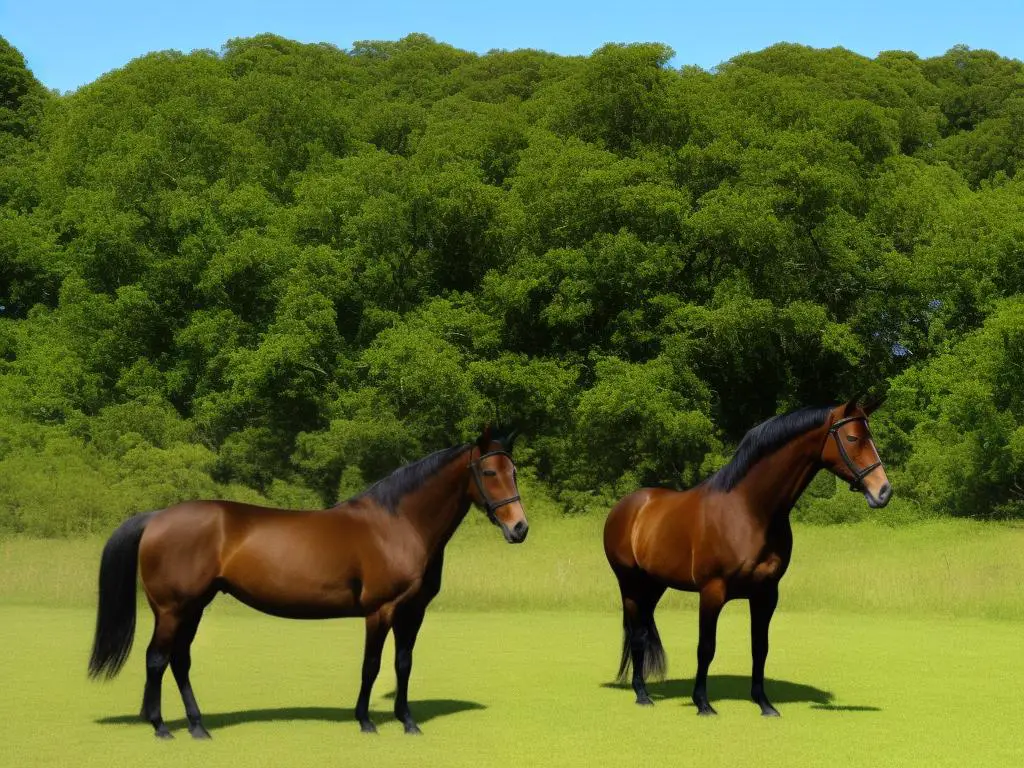When approaching the care and keeping of warmblood horses, one must consider a variety of important factors. From understanding the unique physical needs of these exceptional horses, to getting a deep insight into their temperament and training needs, competent warmblood horse care requires dedication and acquired knowledge. A comprehensive study must not only focus on their dietary requirements, exercise regimen and health screenings, but also highlight the necessity of proper housing facilities and the appropriate usage of equipment. This subject matter is dedicated to providing you the knowledge and guidance needed to meet these high standards of care, focusing on providing a lifestyle suited to the best interest of your warmblood horse.
Table of Contents (Horspedia)
Understanding Warmblood Horse’s Physical Needs
Understanding a Warmblood Horse’s Physical Needs
Warmblood horses are a diverse group of middle-weight breeds, known for their athleticism and versatility. Caring for a warmblood involves a detailed understanding of their unique physical needs. The following steps will guide you through the basics of looking after their diet, exercise, grooming, and health.
Dietary Needs
- Feed Ratios: Warmbloods can thrive on a balanced diet of forage, concentrate, and fresh water. Provide 1.5%-2% of your horse’s body weight in forage daily. For an average 1,200-pound horse, this amounts to 18-24 pounds of hay.
- Concentrates: If your warmblood is an active athlete, you may supplement the hay with grains. However, this shouldn’t be more than 40% of the diet. Split the concentrate ration into two or three smaller meals instead of a single one to minimize risk of digestive problems.
- Supplements: Warmbloods often benefit from joint supplements, Omega-3 fatty acids, and probiotics. Always consult your vet before introducing a new supplement.
Grooming and Care Routines
- Daily Grooming: Regular grooming keeps your horse clean and healthy, helping to identify minor issues before they become problems. Use a curry comb to remove dirt and loose hair, then a body brush to smoothen the coat.
- Hoof Care: Inspect and clean your horse’s hooves every day to prevent thrush (a bacterial infection) and other common issues.
- Dental Check-ups: Warmblood horses should have a dental exam at least once a year. Regular dental care is critical for proper chewing and overall health.
Exercise Needs
- Warmblood horses need regular exercise to maintain health and composure. An hour or more of daily turnout in a safe paddock is ideal, in addition to structured workouts that can include ground-training exercises, rides, or lunges.
- Regular rest days are as important as workout days. A schedule like three days of training, one day off, then another three days of training is a typical example.
Health Requirements and Regular Vet Checks
- Keep track of the warmblood’s baseline health parameters such as heart rate, temperature and respiration rate so you can quickly identify any variations.
- Regular vet checks are important to prevent health issues before they escalate. The vet usually checks cardiovascular system, respiratory system, eyes, dental health, and hooves, among others.
- Warmbloods can be susceptible to certain health issues such as Degenerative Suspensory Ligament Desmitis (DSLD) and Osteochondrosis Dissecans (OCD). Stay vigilant for symptoms and initiate early treatment when needed.
Remember, a happy horse is a healthy horse. Understanding and catering to your warmblood’s physical needs is the best way to ensure they lead a comfortable and fulfilled life.

Understanding Warmblood Horse’s Temperament & Training
Understanding Warmblood Horse’s Temperament
Warmblood horses are known for their calm, even-tempered disposition. However, like all horses, they also have a strong instinct to flee from danger. This means that they can become nervous and skittish if they feel threatened. They are intelligent and sensitive animals who need consistent, gentle handling to feel confident and secure.
Understanding their temperament is the key to effective handling of a warmblood horse. Here are some ways of getting to know your horse better:
- Spend time around them and observe their reactions to different situations and stimuli. This will help you to predict their behavior and tailor your approach accordingly.
- Try to read their body language. Horses communicate a lot through subtle physical signals. Learning to read these will give you a greater insight into their mood and feelings.
- Get to know their personality. Like people, each horse is an individual with their own personality and quirks.
Training Warmblood Horses
When it comes to training your warmblood horse, there are a few key principles to keep in mind:
- Consistency is key. Horses learn through repetition, so it’s important to be consistent in your cues and responses.
- Positive reinforcement works best. Horses respond well to rewards, whether it’s a pat, a kind word, or a treat. Always reward your horse for good behavior or a task well done.
- Keep sessions short. Horses have a relatively short attention span, so try to keep training sessions to around 15-20 minutes at a time. Multiple sessions in a day are more effective than one long one.
- Introduce new concepts slowly. If you’re teaching your horse something new, break it down into small, manageable steps and introduce them gradually.
Communication and Leadership Strategies
Communication and leadership are key in any horse-human relationship. Here are some tips on how to communicate with your warmblood horse and establish yourself as a leader:
- Be firm but gentle. Horses respond best to a leader who is confident and assertive, but also kind and respectful.
- Use body language to communicate. Horses are very perceptive to body language, so use this to your advantage. For example, standing tall and looking your horse in the eye communicates assertiveness.
- Establish boundaries. It’s important to teach your horse to respect your space and to listen to your commands. This helps to establish your leadership and keep you both safe.
Discipline and Bonding Techniques
A good relationship with your horse is founded on trust and respect. Here are some discipline and bonding techniques that can help to build this:
- Be fair and consistent with discipline. If your horse misbehaves, correct them immediately so that they associate the behavior with the consequence. However, always ensure your response is proportionate to the misbehavior.
- Spend quality time with them. Just hanging out with your horse can help to strengthen your bond. Groom them, massage them, or simply sit with them in their stall.
- Involve them in a variety of activities. This helps to keep their mind active and strengthens your relationship by introducing new experiences you can share together.
- Trust and respect are two-way streets. Treat your horse with kindness and respect, and they will return the favor. Learning about warmblood horse care and training requires time, patience, and practice, but the rewards are well worth the effort.

Facilities and Equipment for Warmblood Horses
Facilities and Housing Needs
1. Spacious Stables: Warmblood horses are generally larger than other breeds, so they require larger stables. Each horse should have a stall that is at least 12ft x 12ft. These must be built solidly with safe materials like wood or metal and should have adequate ventilation and natural light.
2. Adequate Pasture: Aside from the stable, warmblood horses need plenty of space to roam and exercise. An area of one to two acres per horse is generally recommended. Ensure the pasture is fenced securely to prevent the horse from wandering off.
3. Outdoor Shelters: If you live in a climate with extreme weather conditions, consider outdoor shelters in the pasture area. These can protect the horse from harsh sun, high winds, or heavy rain.
Bedding and Stable Requirements
1. Bedding Types: The most common types of bedding for warmblood horses are straw and wood shavings. Straw is less expensive but needs to be changed more often. Wood shavings are typically more absorbent and easier to clean.
2. Maintaining Cleanliness: Warmblood horses need clean stables to stay healthy. Remove waste daily, add fresh bedding as needed, and deep-clean the stall regularly.
Understanding the Importance of Safe and Comfortable Living Conditions
1. Safety Considerations: Check the stable and pasture regularly for sharp objects, loose nails, or splintered wood that could harm the horse. Keep all cleaning supplies and feed out of the horse’s reach.
2. Comfort Considerations: To avoid stress and encourage rest, the stable environment should be peaceful and quiet. Warmblood horses also prefer consistency in their routines. Keep feedings and exercise periods regular.
Required Space and Pasture Types
1. Required Space: Warmblood horses need ample space to move and exercise. Aim for a minimum stall size of 12ft x 12ft and at least one acre of pasture land per horse.
2. Pasture Types: Try to provide mixed grass pastures for these horses. A mix of grasses like timothy, fescue, and Bermuda grass usually works well.
Essential Tack and Equipment for Warmblood Horses
1. Saddles: Warmblood horses need a specially fitting saddle due to their size. English-style saddles are generally recommended for these horses.
2. Bridles: Again, size is incredibly important. Warmbloods often require horse or oversize bridles because they tend to have larger heads compared to other horse breeds.
3. Rugs and Blankets: Depending on your local climate, your warmblood may need rugs or blankets to help keep them comfortable. For colder climates, consider a heavier winter rug. Conversely, a lightweight, breathable rug is necessary for warmer climates to protect the horse from flies and sunburn.
Conclusion
Taking care of a warmblood horse involves understanding their size, nature, and special needs. However, with the right facilities, equipment, and care routines, owning a warmblood can be a rewarding experience.

The attention to details, comprehending the physical needs and understanding the personality of your warmblood horse will significantly contribute to their physical health and psychological well-being. Knowledge about their ideal living conditions, and utilizing the right equipment means creating an environment where they can thrive. As you embrace this journey of warmblood horse care, remember that, while it can be quite an undertaking, the rewarding bond formed and your horse’s wellness make all the efforts worthwhile. The above details serve as a foundation to begin this exciting venture, poised to equip you with all the necessary information and serve as a valuable resource throughout your journey.
